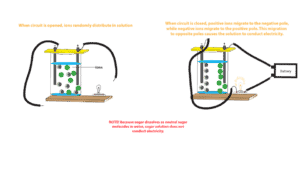Why does salt solution conduct electricity, while sugar solution doesn’t?
Salt solution such as sodium chloride (NaCl) conducts an electric current because it has ions in it that have the freedom to move about in solution. These ions are produced when sodium chloride dissolves in pure water to produce sodium (Na+) and chloride ions (Cl–).
When you insert the electrodes of a conductivity tester in the salt solution, the positive sodium ions usually move to the negative electrode, while the negative chloride ions move to the positive electrode. This movement of ions to opposite ends of the electrodes allow electric current to flow through the solution.
On the other hand, sugar solution does not conduct an electric current because sugar (C12H22O11) dissolves in water to produce sugar molecules. These sugar molecules are usually neutral (not charged), and so are unable to move to the opposite ends of the electrodes like the ions.
Here is a model that illustrates why NaCl conduct electricity when dissolved in water.

Can deionized water conduct electricity?
Deionized water is water in which chemists use a technique called ion exchange to remove or exchange the dissolved ions in it. Once these ions are removed deionized water is a poor conductor of electricity.
Why can’t electrons flow through deionized water to make it conduct?
As it currently stands, nature has made it such that naked electrons can’t flow through water or solutions, but ions can. So, for water or any solution to conduct electricity, mobile ions must be present in it.
So, from our previous discussion of sugar and salt solutions, you can tell that some chemicals dissolve (break apart) in water to produce ions, while others dissolve to produce neutral molecules. When a salt dissolves and produce ions, we call the process dissociation. Therefore, we can say that, sodium chloride dissolves and dissociates, while sugar dissolves without dissociation.
What’s an electrolyte?
An electrolyte is a chemical that dissolves in water and dissociates into ions. An aqueous solution of an electrolyte usually conducts an electric current.
Examples of electrolytes include sodium chloride (NaCl), acetic acid (CH3COOH), sodium hydroxide (NaOH), sulfuric acid (H2SO4), and hydrochloric acid (HCl).
Generally, water soluble ionic compounds are electrolytes. They are electrolytes because ionic compounds consist of oppositely charged ions held together by an ionic bond. As a result, when these ionic compounds dissolve, their ions usually gain the freedom to move about in solution.
To read more about weak and strong electrolyte, click here.
What’s a non-electrolyte?
A nonelectrolyte is a chemical that dissolves in water without producing ions. An aqueous solution of a nonelectrolyte usually doesn’t conduct an electric current.
Examples of nonelectrolytes include sugar (C12H22O11), ethanol (CH3CH2OH), and acetone (CH3OCH3). Generally, water soluble molecular compounds are usually non-electrolytes. However, we do have exceptions. For instance, molecular compounds with the formula HX, where X can be: Cl, Br, and I are polar covalent that dissolve and dissociate in water.
